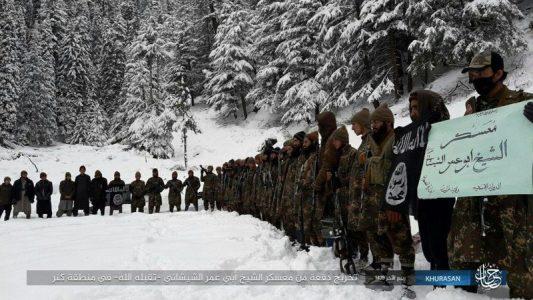
ISIS’s Khorasan province claims responsibility for the terrorist attack on the cultural center in Kabul
A suicide bomber struck the Tabayan cultural center in Kabul, Afghanistan earlier today. The center is located in Kabul’s Qalai Nazir neighborhood, which is predominantly populated by Shiite Muslims. Initial reports indicate that more than 40 people, including women and children, were killed during the attack.
The Islamic State quickly claimed responsibility via its Amaq News Agency, which said that the assault relied on a “martyrdom” seeker, as well as improvised explosive devices. The group attempted to justify the violence by arguing that the facility is a prominent Shiite center and sponsored by Iran. (Amaq’s claim can be seen on the right.)
In a subsequent statement, the Islamic State’s Wilayah Khorasan (or Khorasan “province,” ISIS-K) claimed that the center was an important recruiting station for the Fatemiyoun Division, which is comprised of Afghan Shiites and fights in Syria.
Both statements may have exaggerated the death toll, as the so-called caliphate’s propagandists claimed that 220 people were either killed (100) or wounded (120). Press reports indicate that while the attack was deadly, the number of casualties was lower than the Islamic State claims. Still, there is often uncertainty concerning the number of dead and wounded after a terrorist bombing.
ISIS-K has repeatedly carried out sectarian attacks inside Afghanistan, following the same sectarian strategy employed by the mother organization elsewhere. In July, for instance, ISIS-K claimed responsibility for an assault on the Iraqi embassy in Kabul, saying the operation was part of an “open war” between the Sunni “mujahideen” and the Shiite “polytheists.”
American and Afghan forces have waged an intense counterterrorism campaign against ISIS-K since last year, primarily in the group’s strongholds in Nangarhar province. However, ISIS-K continues to carry out significant operations in Kabul and elsewhere. The self-declared caliphate has poached from existing jihadist to buttress its ranks in Afghanistan and Pakistan. Such defections likely allowed the organization to gain an operational foothold in Kabul in the first place.
The Pentagon reported earlier this month that while “ISIS-K forces were isolated in a small number of districts,” some “small ISIS-K factions fled from their stronghold in Nangarhar to other areas of Afghanistan.”
Indeed, ISIS-K has recently advertised its presence in Kunar province. On Dec. 26, the jihadists released a photo set (seen at the bottom of this article) from Kunar. The camp is named after Abu Omar al-Shishani, an infamous commander who was killed in Iraq in 2016. ISIS-K’s presence in Kunar has long been known, as the US has launched targeted airstrikes against senior leaders stationed in the province.
Despite losing much of their territory in Afghanistan, Abu Bakr al-Baghdadi’s loyalists continue to pose a threat. “Although weakened,” the Defense Department noted in its report this month, “ISIS-K will most likely continue to plan and execute high profile attacks in populated areas.” The bombing in Kabul earlier today illustrates this point.
Source: LWJ





